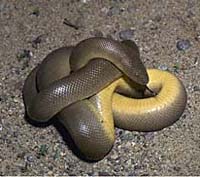Charina bottae
| Coastal rubber boa | |
|---|---|
 |
|
| Scientific classification | |
| Kingdom: | Animalia |
| Phylum: | Chordata |
| Subphylum: | Vertebrata |
| Class: | Reptilia |
| Order: | Squamata |
| Suborder: | Serpentes |
| Family: | Boidae |
| Subfamily: | Erycinae |
| Genus: | Charina |
| Species: | C. bottae |
| Binomial name | |
|
Charina bottae (Blainville, 1835) |
|
| Synonyms | |
The rubber boa (Charina bottae) is a species of snake in the family Boidae. The species is native to the Western United States and British Columbia, Canada.
The name Charina is from the Greek for graceful or delightful, and the name bottae honors Dr. Paolo E. Botta, an Italian ship's surgeon, explorer, and naturalist. The Boidae family consists of the nonvenomous snakes commonly called boas and consists of 43 species. The genus Charina consists of four species, three of which are found in North America, and one species found in Africa. It is sometimes also known as the coastal rubber boa or the northern rubber boa and is not to be confused with the southern rubber boa (Charina umbratica). There is debate on whether the southern rubber boa should be a separate species or a subspecies (Charina bottae umbratica). The only other boa species found in the United States is the rosy boa (Lichanura trivirgata).
Rubber boas are one of the smaller boa species, adults can be anywhere from 38 to 84 centimetres (1.25 to 2.76 ft) long; newborns are typically 19 to 23 centimetres (7.5 to 9.1 in) long. The common name is derived from their skin which is often loose and wrinkled and consists of small scales that are smooth and shiny, these characteristics give the snakes a rubber like look and texture. Colors are typically tan to dark brown with a lighter ventral surface but sometimes olive-green, yellow, or orange. Newborns often appear pink and slightly transparent but darken with age. Rubber boas have small eyes with vertically elliptical pupils and short blunt heads that are no wider than the body. One of the most identifiable characteristics of rubber boas is their short blunt tails that closely resemble the shape of their head. Rubber boas appear quite different visually than any other species that share the same range (except maybe for the southern rubber boa) and thus are usually easy to identify.
Rubber boas are the most northerly of boa species. The distribution of rubber boas covers a large portion of the western United States, stretching from the Pacific Coast east to western Utah and Montana, as far south as the San Bernardino and San Jacinto Mountains east of Los Angeles in California, and as far north as southern British Columbia. There have also been rare sightings in Colorado and Alberta in addition to the states/provinces that they are known to thrive in California, Oregon, Washington, Nevada, Utah, Wyoming, Montana, Idaho, and extending to its northernmost range in British Columbia, this is also the highest latitude of any Boa, that is to say the closest point to either pole for a Boa.
...
Wikipedia

